
Leptospermum is a genus of shrubs and small trees in the myrtle family Myrtaceae commonly known as tea trees, although this name is sometimes also used for some species of Melaleuca. Most species are endemic to Australia, with the greatest diversity in the south of the continent, but some are native to other parts of the world, including New Zealand and Southeast Asia. Leptospermums all have five conspicuous petals and five groups of stamens which alternate with the petals. There is a single style in the centre of the flower and the fruit is a woody capsule.

Nothofagus, also known as the southern beeches, is a genus of 43 species of trees and shrubs native to the Southern Hemisphere in southern South America and east and southeast Australia, New Zealand, New Guinea, and New Caledonia. The species are ecological dominants in many temperate forests in these regions. Some species are reportedly naturalised in Germany and Great Britain. The genus has a rich fossil record of leaves, cupules, and pollen, with fossils extending into the late Cretaceous period and occurring in Australia, New Zealand, Antarctica, and South America.

The Hepialidae are a family of insects in the lepidopteran order. Moths of this family are often referred to as swift moths or ghost moths.

Abantiades is a genus of moths of the family Hepialidae. There are 37 described species, all found exclusively in Australia. The group includes some large species with a wingspan of up to 160 mm. The larvae feed on the roots of Eucalyptus and other trees. Simonsen's 2018 revision of the Australian Hepialidae synonymized the genera Bordaia and Trictena to Abantiades, and included the former genera's species here.

Endoclita is a genus of moths of the family Hepialidae. There are 60 described species found in eastern and southeast Asia and the Indian subcontinent.
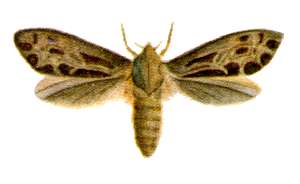
Oncopera is a genus of moths of the family Hepialidae. There are 12 described species, all endemic to Australia. The larvae usually feed on grasses, although that of O. intricata has been recorded on strawberry.
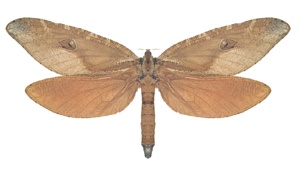
Zelotypia is a monotypic moth genus of the family Hepialidae. The only described species is Z. stacyi, the bentwing ghost moth, which is only found in Queensland and New South Wales, Australia. This is a very large species with a wingspan of up to 250 mm. The larva feeds and pupates in the trunks and branches of Eucalyptus.

The Pergidae are a moderate-sized family of sawflies occurring in the Western Hemisphere and the Australasian Region. The Pergidae are, with almost 450 described species, the third-largest family of Symphyta after the Tenthredinidae and the Argidae. Morphologically, most pergids are typically sawfly-like, but the form of the antennae varies considerably in number of segments and from simple to serrate and pectinate or even bipectinate. Sexual dimorphism is common and reflected in differences in type of antennae, colour, and size. Included are some of the few known apterous sawflies, those of the genus Cladomacra occurring in Papua New Guinea and Indonesia, and a species with brachypterous females, Clarissa tasbates, in Tasmania.
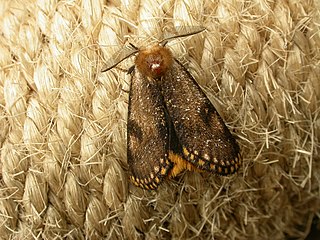
Epicoma contristis, the yellow-spotted epicoma, is a moth of the family Notodontidae first described by Jacob Hübner in 1823. It is known from Australia, including Tasmania, New South Wales and Victoria.

Aenetus ligniveren, the common splendid ghost moth, is a moth in the family Hepialidae. It is found from southern Queensland to Tasmania.

Aenetus eximia is a moth of the family Hepialidae. It is known from southern Queensland, Australia, to Tasmania.
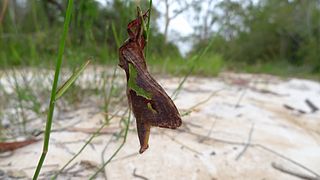
Aenetus lewinii is a moth of the family Hepialidae. It is known from New South Wales and Queensland.
Aenetus ramsayi, the swift ghost moth, is a moth of the family Hepialidae. It is known from Queensland and New South Wales.
Aenetus splendens is a moth of the family Hepialidae. It is known from New South Wales and Queensland.
Aenetus tegulatus is a moth of the family Hepialidae. It is known from south-eastern Papua New Guinea, the Northern Territory and Queensland.

Endoclita malabaricus is a species of moth of the family Hepialidae. It is known from India.
Abantiades argyrosticha is a species of moth of the family Hepialidae. It was described by Turner in 1929, and is endemic to New South Wales and Queensland.
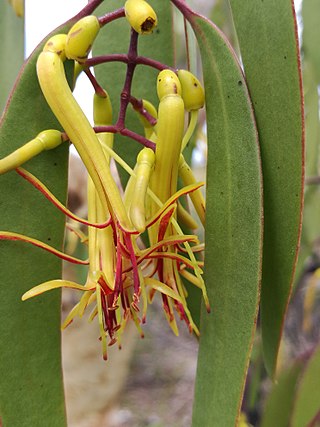
Muellerina eucalyptoides, commonly known as creeping mistletoe, is a hemiparasitic aerial shrub in the family Loranthaceae. The species is endemic to Australia.

The River-flat eucalypt forest or Coastal floodplain eucalypt forest is a critically endangered threatened ecological community that is primarily found in southeastern Australia, from southeastern Queensland, through New South Wales, to eastern Victoria, on alluvial soils of the coastal floodplains. The name chiefly refers to its riparian and floodplain landscape location and the predominant tree canopy being Eucalyptus, Angophora and/or Corymbia, which may exceed 40 m in height.















